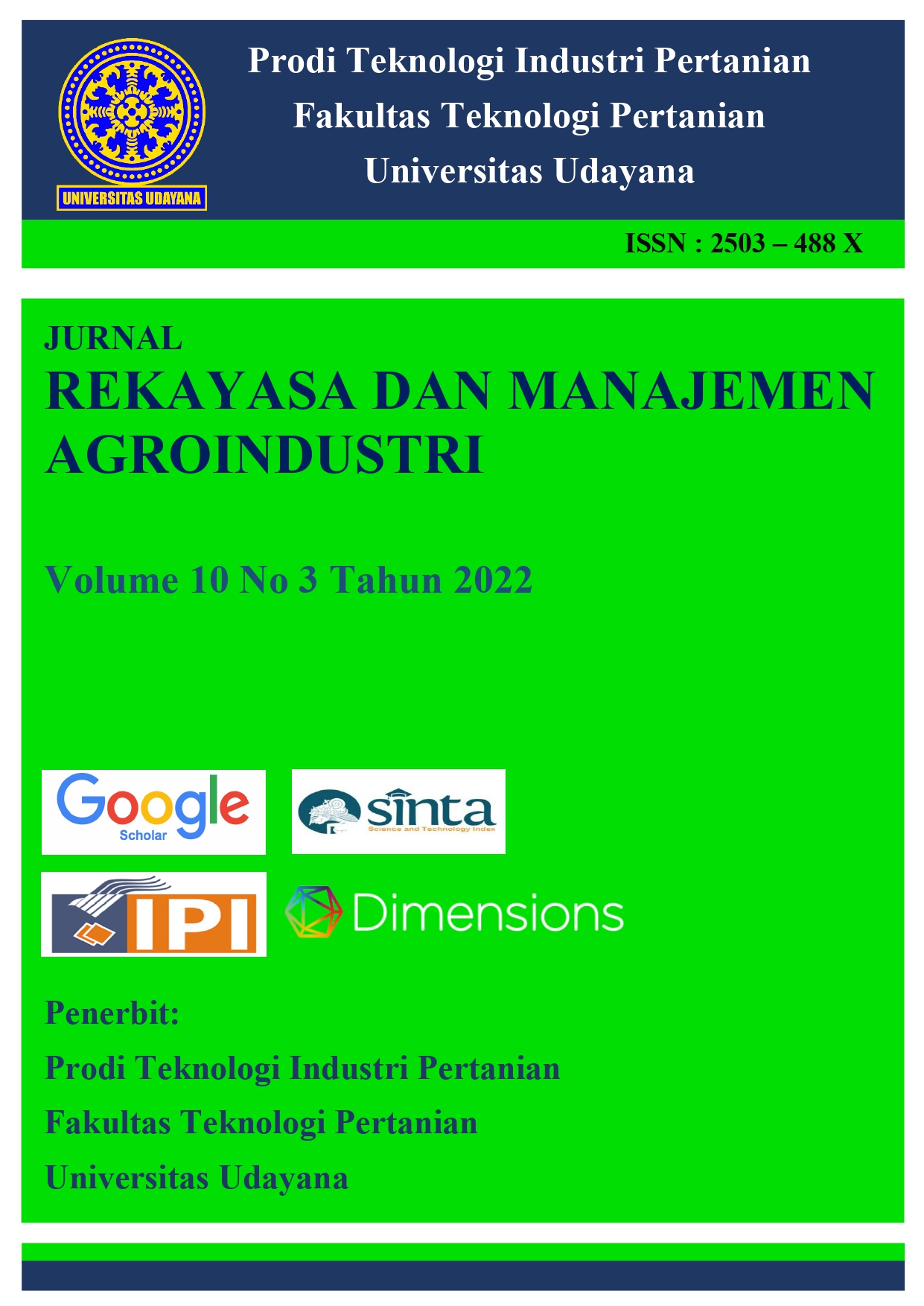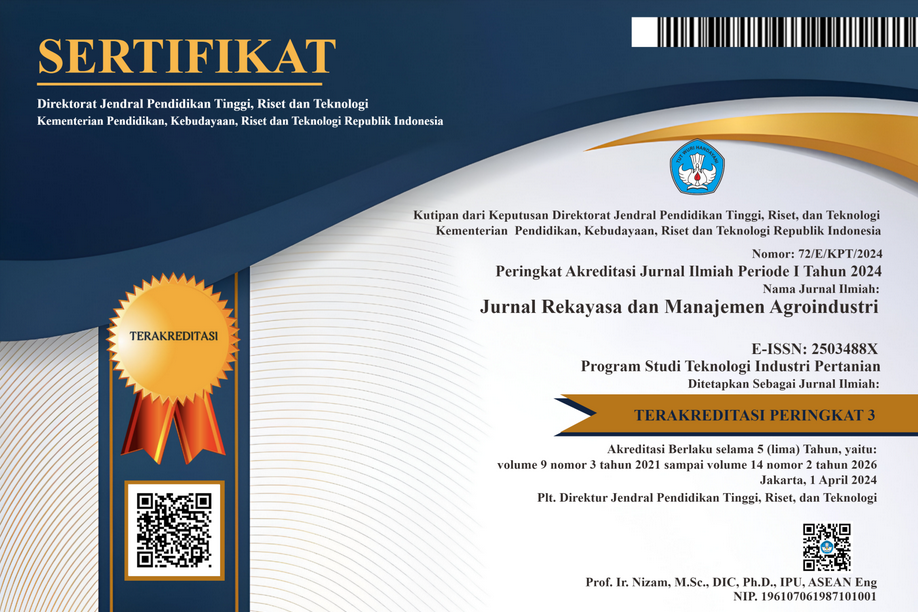EVALUASI SUHU AWAL PENYEDUHAN TERHADAP KARAKTERISTIK FISIKOKIMIA DAN SENSORIS TEH SERAI WANGI (Cymbopogon nardus L.) PRODUKSI PT. KARSA ABADI
Abstract
Herbal tea is a tea that is not made from tea leaves (Cameliia sinensis) but is made from raw materials of flowers, leaves, seeds, roots or dried fruits that are usually healthy and don’t contain caffeine. One of the ingredients used in making herbal tea is lemongrass. The purpose of this study is to determine the effect of the initial temperature of brewing on the physicochemical and sensory characteristics of lemongrass tea and determine the initial temperature of brewing in producing lemongrass tea with the best physicochemical and sensory characteristics. The initial temperature of brewing which consists of five levels, namely 60ºC, 70ºC, 80ºC, 90ºC and 100ºC. The results showed that the initial brewing temperature treatment greatly affected the physicochemical and organoleptic characteristics. The higher the initial brewing temperature treatment, the resulting lemongrass tea with the best physicochemical and organoleptic characteristics, the initial temperature treatment of brewing 100ºC resulted in a total phenolic characteristic of 0.46±0.02 mg GAE/g, IC50 antioxidant activity of 6,610.13±90.53 ppm, water soluble essence of 10.32%. brightness level (L*) 14.56±0.18, reddish level (a*) 8.89±0.19, yellowish level (b*) 12.00±0.37. The best products selected from the sensory assessment were with a color score of 3.1±0.64 (yellowish green), a taste score of 3.6±0.75 (slightly bitter), a scent scoring of 4.2±0.77 (lemongrass-scented), and an overall reception of 5.65±1.14 (somewhat like).
Downloads
References
[2] D. Rohdiana, W. Cahyadi, dan T. Risnawati, “Aktivitas penangkapan radikal bebas DPPH (1,1-Diphenyl-2-Picrylhidrazyl) beberapa jenis minuman,” Jurnal Teknologi Pertanian, vol. 3, no. 2, pp. 79-81, 2008.
[3] Ajisaka, Teh Khasiatnya Dahsyat. Surabaya, CA: Penerbit Stomata, 2012.
[4] R. I. Fajar, L. P. Wrasiati, dan L. Suhendra, “Kandungan senyawa flavonoid dan aktivitas antioksidan ekstrak teh hijau pada perlakuan suhu awal dan lama penyeduhan,” Jurnal Rekayasa dan Manajemen Agroindustri ISSN, vol. 6, no. 3, pp. 197-202, 2018.
[5] B. B. Sasmito, dan D. Dearta, “Pengaruh suhu dan waktu penyeduhan teh hijau daun Sonneratia alba terhadap aktivitas antioksidannya,” JFMR (Journal of Fisheries and Marine Research), vol. 4 no. 1, pp. 109-115, 2020.
[6] I. W. E. P. Putra, L. P. Wrasiati. dan N. M. Wartini, “Pengaruh suhu awal dan lama penyeduhan terhadap karakteristik sensoris dan warna teh putih silver needle (Camellia assamica) produksi PT. Bali Cahaya Amerta,” Jurnal Rekayasa dan Manajemen Agroindustri ISSN, vol. 8, no. 4, pp. 492-501, 2020.
[7] S. Sakanaka, Y. Tachibana, Okad and Yuki, ”Preparation and antioxidant properties of extract of Japanese persimmon leaf (Kakinocha-cha),” Food Chemistry, vol. 89, no. 4, pp. 569-575, 2005, doi: 10.1016/j.foodchem.2004.03.013.
[8] I G. A. K. Dewi, L. P. Wrasiati, dan G. P. G. Putra, “Karakteristik teh daun bambu tali (Gigantochloa apus Kurz.) pada metode blansir dan suhu pengeringan,” Jurnal Rekayasa dan Manajemen Agroindustri ISSN, vol. 8, no. 3, pp. 388-398, 2020.
[9] Kemenkes RI, Suplemen II farmakope herbal Indonesia, Edisi I. Jakarta, CA: Kementrian Kesehatan Republik Indonesia, 2011.
[10] C. Weafer, The Food Chemistry Laboratory. Boca Raton, New York, London, Tokyo, CA: CRC Press, 1996.
[11] Standar Nasional Indonesia (SNI), “Simplisia Kencur,” Badan Standardisasi Nasional (BSN), 2005.
[12] A. C. Erungan, B. Ibrahim, dan A. N. Yudistira, “Analisis pengambilan keputusan uji organoleptik dengan metode multi kriteria.” Jurnal Pengolahan Hasil Perikanan Indonesia, vol. 8, no. 1, pp. 1-7, 2005.
[13] M. Muzaifa, Hasni, D., Arpi, N., Sulaiman, M. I., & Limbong, M. S, “Kajian pengaruh perlakuan pulp dan lama penyeduhan terhadap mutu kimia teh cascara,” Jurnal Teknologi Pertanian Andalas, vol. 23, no. 2, pp. 136-142. 2019.
[14] N. W. Martiningsih, G. A. B. Widana, & Kristiyanti, P. L. P, “Skrining fitokimia dan uji aktivitas antioksidan ekstrak etanol daun Matoa (Pometia pinnata) dengan metode DPPH,” In Prosiding Seminar Nasional MIPA, 2016, pp. 332-338.
[15] A.T. Hapsari, “Pengaruh temperatur dan rasio F:S terhadap aktivitas antioksidan, kadar flavonoid, dan kadar total fenol dalam ekstraksi antioksidan daun salam,” Skripsi, Universitas Katolik Parahyangan, Bandung. 2013.
[16] F. L. Ariyani, E. Setiawan, dan F. E. Soetaredjo, “Ekstraksi minyak atsiri dari tanaman sereh dengan menggunakan pelarut metanol, aseton, dan n-heksana,” Widya teknik, vol. 7, no. 2, pp. 124-133, 2017.
[17] R. Supriningrum, Fatimah, N., & Purwanti, Y. E, “Karakterisasi spesifik dan non spesifik ekstrak etanol daun putat (Planchonia valida),” AL-ULUM: Jurnal Sains dan Teknologi, vol. 5, no. 1, pp. 6-12. 2019.
[18] Departemen Kesehatan Republik Indonesia, Farmakope Herbal Indonesia (Edisi VII). Jakarta, CA: Departemen Kesehatan Republik Indonesia, 2000.
[19] R. Ramlah, “Penentuan suhu dan waktu optimum penyeduhan daun the hijau (Camellia sinensis L.) P+2 terhadap kandungan antioksidan, kafein, tanin dan katekin,” Skripsi, UIN Alauddin, Makassar. 2017.
[20] W. Ciptadi, dan M.Z. Nasution, Mempelajari Cara Pemanfaatan Teh Hitam Mutu Rendah untuk Pembuatan Teh Dadak. Institut Pertanian Bogor, Bogor. 1979.

Ciptaan disebarluaskan di bawah Lisensi Creative Commons Atribusi-BerbagiSerupa 4.0 Internasional.
Seluruh artikel di Jurnal ini dapat disebarluaskan atas tetap mencantumkan sumber yang syah. Identitas judul artikel tidak boleh dihilangkan. Penerbit tidak bertangggung jawab terhadap naskah yang dipublikasikan. Isi artikel menjadi tanggung jawab Penulis.














